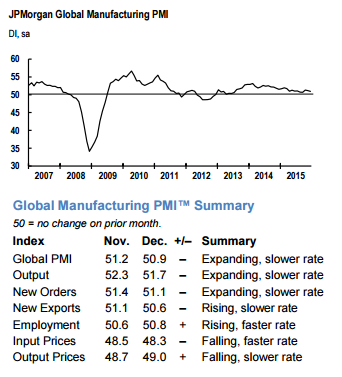Economy

Global Manufacturing Ends 2015 on a Weak Note
Written by Sandy Williams
January 5, 2016
Manufacturing ended the year with general global slowing as production and new orders declined. The JP Morgan Global Manufacturing PMI registered 50.9 in December, down from 51.2 in November. The global PMI average for 2015 failed to surpass the average reading for the prior two years.
PMI indices for China, India, Brazil, Russia, Indonesia and Malaysia ended the year in contraction. Expansion slowed in the U.S. and U.K. but remained steady in Japan. With the recovery of Greece, the EU nations were all in growth territory for the first time since April 2014.
Global pricing remained on the downside in December with decreasing input costs and output charges.
Commenting on the survey, David Hensley, Director of Global Economic Coordination at JP Morgan, said: “Global manufacturing ended 2015 on a subdued footing, as the ongoing downturns in emerging markets such as China, Brazil, India and Russia remained a drag on global IP growth. Sector PMI data launched today show that weak investment and business-to-business spending are the main drags on global growth, while consumer goods demand continues to be a positive driver of growth.”
North America
Manufacturing in North America softened in December with the U.S. and Mexico slowing down to end the year. Canada continued its downward spiral in the manufacturing sector.
Manufacturing ended on a weak note in the U.S according to the Markit U.S. Manufacturing PMI. The headline index fell to 51.2, well below the survey average of 54.2 for the year and down from 52.8 in November. New order levels were nearly flat domestically and from abroad. Production slowed to match weaker demand, reducing capacity pressure and decreasing backlogs. Input buying decreased last month for the first time in a year-and-a-half as firms streamlined inventory. Raw material prices continued to fall and survey respondents, in particular, noted low steel prices.
Chris Williamson, chief economist at Markit, commented: “Order book growth has stalled as producers report some of the toughest trading conditions since the end of the global financial crisis. The strong dollar is hurting exporters as well as hitting domestic sales as firms compete against inflows of cheap imports. Low oil prices are meanwhile hitting demand for goods and machinery from the energy sector. There are signs that consumers are becoming more cautious in relation to spending as interest rates lift off their historic lows, and overseas demand remains in the doldrums. All of these factors look set to continue to hurt manufacturers, and even intensify, in coming months. However, with the Fed stressing that the trajectory of interest rates will be data dependent, any extended period of weakness at least suggests that the rate hiking process will be very gradual.”
Manufacturing activity in Mexico expanded at a slower pace in December. The headline index registered 52.4, down from 53.0 in November and the lowest since September. New orders increased along with higher export sales resulting in a modest increase in production. Preproduction inventories rose as manufacturers increased stocks to meet growing demand and supplier lead times quickened. Manufacturing costs increased in December and was linked to higher prices for imported materials.
Canada manufacturers saw another reduction in output volume and new orders at the end of 2015. The RBC Canadian Manufacturing PMI registered 47.5, its fifth month in contraction and a new record low for December. “Weaker domestic demand and ongoing uncertainty in the energy sector continues to take its toll,” said Craig Wright, senior vice-president and chief economist, RBC. Export sales picked up slightly.
Eurozone
The Eurozone Manufacturing PMI rose to 53.2 in December, up from 52.8 in November, its highest level since April 2014. The PMI average of 52.8 for the quarter was the best since Q1 2014 and the 2015 average exceeded that of the prior three years. Production increased as new orders and new export business improved. Manufacturing in Greece expanded in December bring the Greek PMI to 50.2. Italy’s PMI was at a 57 month high of 55.6. The region which has experience sustained high levels of unemployment in some nations saw solid employment gains in December. Although the PMI results were positive in December, economist Rob Dobson at Markit said “the underlying picture is still one of solid yet unspectacular expansion” and there is a “distance to travel before the climb back to full recovery is completed.”
Asia
Manufacturing in China continued to deteriorate in December. The Caixin China General Manufacturing PMI fell to 48.2 from November’s reading of 48.6, signaling worsening conditions in the manufacturing sector. Production declined for the seventh time in the past eight months on weak domestic and international demand. New orders and new export orders both fell in December. Employment levels were trimmed as a result of production cuts. Decreased input costs were passed to clients as lower selling prices.
Dr. Hei Fan, Chief Economist at Caixin Insight Group, said “the economy is facing a greater risk of weakening.” Citing more global market fluctuations due to rising interest rates in the U.S., Fan said, “The government needs to pay more attention to external risk factors in the short term and fine-tune macroeconomic policies accordingly so the economy does not fall off a cliff. It needs to simultaneously push forward the supply-side reform to release its potential and reap the benefits.”
The Nikkei Japan Manufacturing PMI was unchanged in December, posting a strong 52.6 for the month. New orders increased from new product launches and advertising campaigns and was supported by a third month of expansion for new exports. Increased demand resulted in higher production and employment. Inflationary pressures eased with lower input costs resulting in slightly reduced selling prices. The quarterly PMI average was the strongest since first quarter 2014.
As exports fell in South Korea and China, Vietnam emerged with the first solid expansion of new export demand since May. The increase in demand pushed the Vietnam manufacturing sector back into growth territory.
Russia
Manufacturing activity continued to deteriorate in Russia, driven by a modest drop in production and a decline in new orders. Inventory levels decreased as buying activity slowed. The PMI posted 48.7, falling back into contraction for the first time in three months. Markit economist Samuel Agass said, “Latest survey figures suggest manufacturers may endure a challenging start to 2016 unless some action can be taken to stimulate demand for goods.”

Sandy Williams
Read more from Sandy WilliamsLatest in Economy

Steel groups welcome passage of budget bill
Steel trade groups praised the passage of the Big Beautiful Bill (BBB) in Congress on Thursday.

Industry groups praise Senate for passing tax and budget bill
The Steel Manufacturers Association and the American Iron and Steel Institute applauded the tax provisions included in the Senate's tax and budget reconciliation bill.

Chicago PMI dips 0.1 points in June
The Chicago Purchasing Managers Index (PMI) slipped 0.1 points to 40.4 points, in June.

Multi-family pullback drives housing starts to 5-year low in May
US housing starts tumbled in May to a five-year low, according to figures recently released by the US Census Bureau.

Architecture firms still struggling, ABI data shows
Architecture firms reported a modest improvement in billings through May, yet business conditions remained soft, according to the latest Architecture Billings Index (ABI) release from the American Institute of Architects (AIA) and Deltek.

